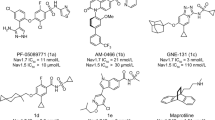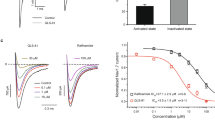Abstract
Voltage-gated sodium channel 1.7 (Nav1.7) remains one of the most promising drug targets for pain relief. In the current study, we conducted a high-throughput screening of natural products in our in-house compound library to discover novel Nav1.7 inhibitors, then characterized their pharmacological properties. We identified 25 naphthylisoquinoline alkaloids (NIQs) from Ancistrocladus tectorius to be a novel type of Nav1.7 channel inhibitors. Their stereostructures including the linkage modes of the naphthalene group at the isoquinoline core were revealed by a comprehensive analysis of HRESIMS, 1D, and 2D NMR spectra as well as ECD spectra and single-crystal X-ray diffraction analysis with Cu Kα radiation. All the NIQs showed inhibitory activities against the Nav1.7 channel stably expressed in HEK293 cells, and the naphthalene ring in the C-7 position displayed a more important role in the inhibitory activity than that in the C-5 site. Among the NIQs tested, compound 2 was the most potent with an IC50 of 0.73 ± 0.03 µM. We demonstrated that compound 2 (3 µM) caused dramatical shift of steady-state slow inactivation toward the hyperpolarizing direction (V1/2 values were changed from −39.54 ± 2.77 mV to −65.53 ± 4.39 mV, which might contribute to the inhibition of compound 2 against the Nav1.7 channel. In acutely isolated dorsal root ganglion (DRG) neurons, compound 2 (10 μM) dramatically suppressed native sodium currents and action potential firing. In the formalin-induced mouse inflammatory pain model, local intraplantar administration of compound 2 (2, 20, 200 nmol) dose-dependently attenuated the nociceptive behaviors. In summary, NIQs represent a new type of Nav1.7 channel inhibitors and may act as structural templates for the following analgesic drug development.

This is a preview of subscription content, access via your institution
Access options
Subscribe to this journal
Receive 12 print issues and online access
$259.00 per year
only $21.58 per issue
Buy this article
- Purchase on Springer Link
- Instant access to full article PDF
Prices may be subject to local taxes which are calculated during checkout






Similar content being viewed by others
References
Catterall WA. From ionic currents to molecular mechanisms: the structure and function of voltage-gated sodium channels. Neuron. 2000;26:13–25.
Melnikova DI, Khotimchenko YS, Magarlamov TY. Addressing the issue of tetrodotoxin targeting. Mar Drugs. 2018;16:1053–61.
Djouhri L, Newton R, Levinson SR, Berry CM, Carruthers B, Lawson SN. Sensory and electrophysiological properties of guinea-pig sensory neurones expressing Nav1.7 (PN1) Na+ channel alpha subunit protein. J Physiol. 2003;546:565–76.
Bosmans F, Swartz KJ. Targeting voltage sensors in sodium channels with spider toxins. Trends Pharmacol Sci. 2010;31:175–82.
Vetter I, Deuis JR, Mueller A, Israel MR, Starobova H, Zhang A, et al. NaV1.7 as a pain target—from gene to pharmacology. Pharmacol Ther. 2017;172:73–100.
Goodwin G, McMahon SB. The physiological function of different voltage-gated sodium channels in pain. Nat Rev Neurosci. 2021;22:263–74.
Alsaloum M, Higerd GP, Effraim PR, Waxman SG. Status of peripheral sodium channel blockers for non-addictive pain treatment. Nat Rev Neurol. 2020;16:689–705.
Li ZM, Chen LX, Li H. Voltage-gated sodium channels and blockers: an overview and where will they go? Curr Med Sci. 2019;39:863–73.
Mulcahy JV, Pajouhesh H, Beckley JT, Delwig A, Du Bois J, Hunter JC. Challenges and opportunities for therapeutics targeting the voltage-gated sodium channel isoform Nav1.7. J Med Chem. 2019;62:8695–710.
Kingwell K. Nav1.7 withholds its pain potential. Nat Rev Drug Discov. 2019;18:321–3.
Bringmann G, Zhang G, Olschlager T, Stich A, Wu J, Chatterjee M, et al. Highly selective antiplasmodial naphthylisoquinoline alkaloids from Ancistrocladus tectorius. Phytochemistry. 2013;91:220–8.
Tshitenge DT, Feineis D, Mudogo V, Kaiser M, Brun R, Bringmann G. Antiplasmodial ealapasamines A-C, 'mixed' naphthylisoquinoline dimers from the central african liana Ancistrocladus ealaensis. Sci Rep. 2017;7:5767.
Bringmann G, Seupel R, Feineis D, Xu M, Zhang G, Kaiser M, et al. Antileukemic ancistrobenomine B and related 5,1'-coupled naphthylisoquinoline alkaloids from the Chinese liana Ancistrocladus tectorius. Fitoterapia. 2017;121:76–85.
Seupel R, Hemberger Y, Feineis D, Xu M, Seo EJ, Efferth T, et al. Ancistrocyclinones A and B, unprecedented pentacyclic N,C-coupled naphthylisoquinoline alkaloids, from the Chinese liana Ancistrocladus tectorius. Org Biomol Chem. 2018;16:1581–90.
Tang CP, Yang YP, Zhong Y, Zhong QX, Wu HM, Ye Y. Four new naphthylisoquinoline alkaloids from Ancistrocladus tectorius. J Nat Prod. 2000;63:1384–7.
Li J, Seupel R, Feineis D, Mudogo V, Kaiser M, Brun R, et al. Dioncophyllines C2, D2, and F and related naphthylisoquinoline alkaloids from the Congolese liana Ancistrocladus ileboensis with potent activities against plasmodium falciparum and against multiple myeloma and leukemia cell lines. J Nat Prod. 2017;80:443–58.
Aswathanarayan JB, Vittal RR. In vitro evaluation of antioxidant and antibacterial activities of Rotula aquatica and Ancistrocladus heyneanus. J Pharm Res. 2013;6:313–7.
Dubuisson D, Dennis SG. The formalin test: a quantitative study of the analgesic effects of morphine, meperidine, and brain stem stimulation in rats and cats. Pain. 1977;4:161–74.
Tjolsen A, Berge OG, Hunskaar S, Rosland JH, Hole K. The formalin test: an evaluation of the method. Pain. 1992;51:5–17.
Abbott FV, Franklin KBJ, Westbrook FR. The formalin test: scoring properties of the first and second phases of the pain response in rats. Pain. 1995;60:91–102.
McNamara CR, Mandel BJ, Bautista DM, Siemens J, Deranian KL, Zhao M, et al. TRPA1 mediates formalin-induced pain. Proc Natl Acad Sci USA. 2007;104:13525–30.
GBD 2017 DALYs and HALE Collaborator. Global, regional, and national disability-adjusted life-years (DALYs) for 333 diseases and injuries and healthy life expectancy (HALE) for 195 countries and territories, 1990-2016: a systematic analysis for the Global Burden of Disease Study 2016. Lancet. 2017;390:1260–344.
Gaskin DJ, Richard P. The economic costs of pain in the United States. J Pain. 2012;13:715–24.
Yam MF, Loh YC, Tan CS, Khadijah Adam S, Abdul Manan N, Basir R. General pathways of pain sensation and the major neurotransmitters involved in pain regulation. Int J Mol Sci. 2018;19:2164–87.
Yang Y, Wang Y, Li S, Xu Z, Li H, Ma L, et al. Mutations in SCN9A, encoding a sodium channel alpha subunit, in patients with primary erythermalgia. J Med Genet. 2004;41:171–4.
Fertleman CR, Baker MD, Parker KA, Moffatt S, Elmslie FV, Abrahamsen B, et al. SCN9A mutations in paroxysmal extreme pain disorder: allelic variants underlie distinct channel defects and phenotypes. Neuron. 2006;52:767–74.
Ma RSY, Kayani K, Whyte-Oshodi D, Whyte-Oshodi A, Nachiappan N, Gnanarajah S, et al. Voltage gated sodium channels as therapeutic targets for chronic pain. J Pain Res. 2019;12:2709–22.
Sheets PL, Jarecki BW, Cummins TR. Lidocaine reduces the transition to slow inactivation in Nav1.7 voltage-gated sodium channels. Br J Pharmacol. 2011;164:719–30.
Chevrier P, Vijayaragavan K, Chahine M. Differential modulation of Nav1.7 and Nav1.8 peripheral nerve sodium channels by the local anesthetic lidocaine. Br J Pharmacol. 2004;142:576–84.
Zheng YM, Wang WF, Li YF, Yu Y, Gao ZB. Enhancing inactivation rather than reducing activation of Nav1.7 channels by a clinically effective analgesic CNV1014802. Acta Pharmacol Sin. 2018;39:587–96.
Xing JL, Hu SJ, Xu H, Han S, Wan YH. Subthreshold membrane oscillations underlying integer multiples firing from injured sensory neurons. NeuroReport. 2001;12:1311–3.
Wu Q, Henry JL. Delayed onset of changes in soma action potential genesis in nociceptive A-beta DRG neurons in vivo in a rat model of osteoarthritis. Mol Pain. 2009;5:57.
Niu HL, Liu YN, Xue DQ, Dong LY, Liu HJ, Wang J, et al. Inhibition of Nav1.7 channel by a novel blocker QLS-81 for alleviation of neuropathic pain. Acta Pharmacol Sin. 2021;42:1235–47.
Huang J, Mis MA, Tanaka B, Adi T, Estacion M, Liu S, et al. A typical changes in DRG neuron excitability and complex pain phenotype associated with a Nav1.7 mutation that massively hyperpolarizes activation. Sci Rep. 2018;8:1811.
Alexandrou AJ, Brown AR, Chapman ML, Estacion M, Turner J, Mis MA, et al. Subtype-selective small molecule inhibitors reveal a fundamental role for Nav1.7 in nociceptor electrogenesis, axonal conduction and presynaptic release. PLoS One. 2016;11:e0152405.
Kim DM, Nimigean CM. Voltage-gated potassium channels: a structural examination of selectivity and gating. Cold Spring Harb Perspect Biol. 2016;8:a029231.
Cao XH, Byun HS, Chen SR, Cai YQ, Pan HL. Reduction in voltage-gated K+ channel activity in primary sensory neurons in painful diabetic neuropathy: role of brain-derived neurotrophic factor. J Neurochem. 2010;114:1460–75.
Acknowledgements
This work was supported by the National Science Fund for Distinguished Young Scholars (grant No. 81825021), the Youth Innovation Promotion Association of the Chinese Academy of Sciences (grant No. 2020284), the Fund of Science and Technology Commission of Shanghai Municipality (grant No. 19431906000), the Key-Area Research and Development Program of Guangdong Province (grant No. 2020B0303070002), High-level New R&D Institute (grant No. 2019B090904008) and High-level Innovative Research Institute (grant No. 2021B0909050003) from Department of Science and Technology of Guangdong Province, Zhongshan Municipal Bureau of Science and Technology, the Lingang Laboratory (LG202103-01-06, LG202103-01-05), and the National Science and Technology Innovation 2030 Major Program (grant No. 2021ZD0200900).
Author information
Authors and Affiliations
Contributions
SY, YMZ, ZBG and YY conceived and designed the research; QQW, LW and WBZ performed experiments; QQW and LW analyzed the data; CPT and XQC were in charge of resources and softwares; QQW, LW, YMZ, SY, ZBG and YY wrote and reviewed the manuscript. All authors discussed the study.
Corresponding authors
Ethics declarations
Competing interests
The authors declare no competing interests.
Supplementary information
Rights and permissions
Springer Nature or its licensor (e.g. a society or other partner) holds exclusive rights to this article under a publishing agreement with the author(s) or other rightsholder(s); author self-archiving of the accepted manuscript version of this article is solely governed by the terms of such publishing agreement and applicable law.
About this article
Cite this article
Wang, Qq., Wang, L., Zhang, Wb. et al. Naphthylisoquinoline alkaloids, a new structural template inhibitor of Nav1.7 sodium channel. Acta Pharmacol Sin 44, 1768–1776 (2023). https://doi.org/10.1038/s41401-023-01084-9
Received:
Accepted:
Published:
Issue Date:
DOI: https://doi.org/10.1038/s41401-023-01084-9



